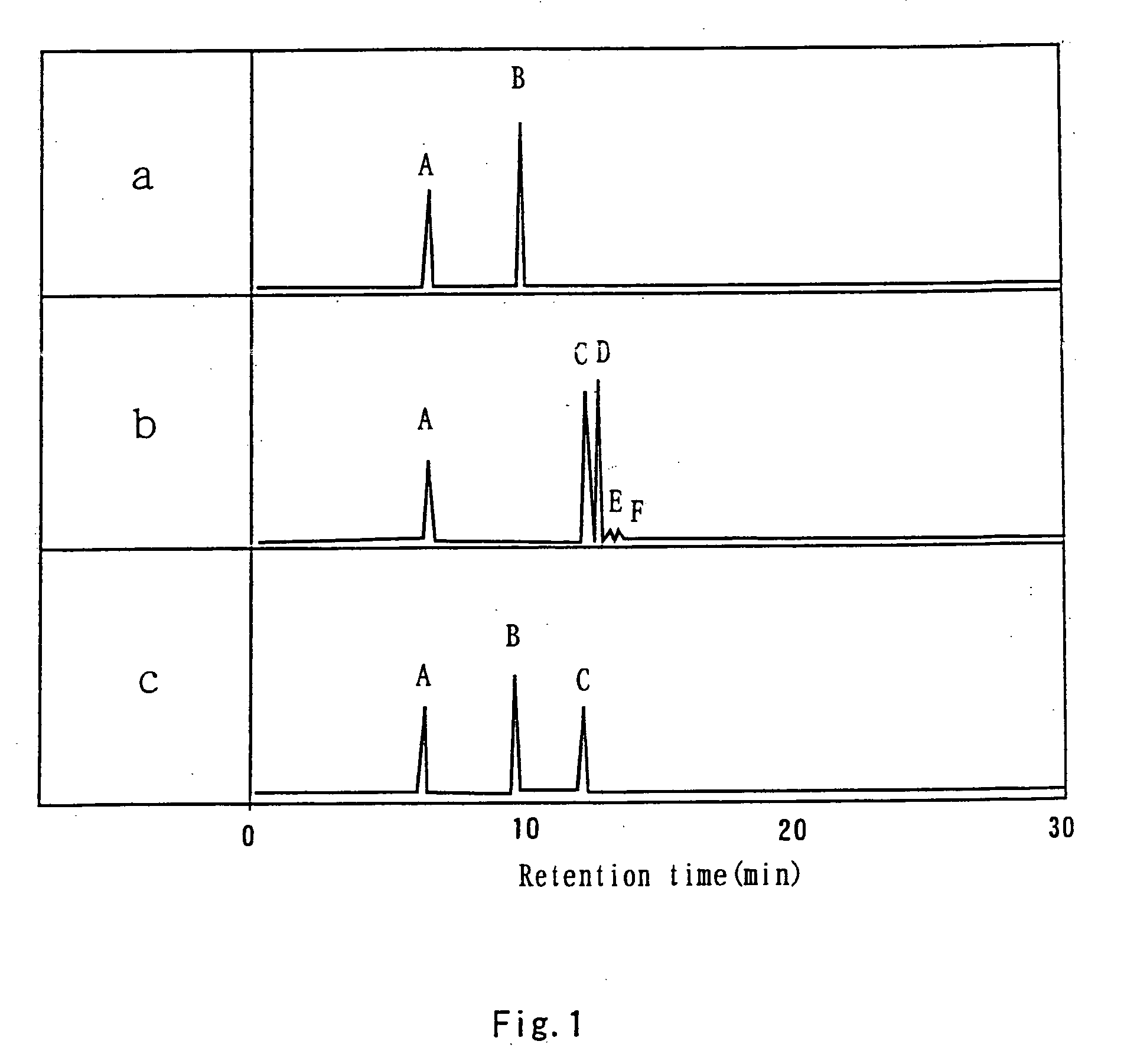Process for producing conjugated fatty acid and food/drink produced by the process
a technology process, which is applied in the direction of sugar food ingredients, food preparation, bacteria-based processes, etc., can solve the problems of little investigation on the production of substances, no microorganisms that produce a sufficient amount of conjugated fatty acid with less by-products, and no evidence of conjugated fatty acid
- Summary
- Abstract
- Description
- Claims
- Application Information
AI Technical Summary
Benefits of technology
Problems solved by technology
Method used
Image
Examples
example 1
Screening of Bacteria Belonging to the Genus Lactobacillus and Producing a Conjugated Fatty Acid
[0072]In 1 mL of a 100 mM phosphate buffer (pH 6.5) were dissolved 50 mg of linoleic acid and 10 mg of BSA to yield a solution of a complex between linoleic acid and BSA.
[0073]Bacteria belonging to the genus Lactobacillus were inoculated to 15 mL of MRS medium (LACTOBACILLI MRS BROTH, a product of DIFCO) containing 0.07% of linoleic acid and cultivated at 28° C. for 20 hours with shaking at 120 rpm. The cultured mixture had a pH of 4.7.
[0074]The cultured mixture was subjected to centrifugal separation to collect cells, and the cells were washed twice with physiological saline to yield washed cells. The washed cells were mixed with 100 μL of the solution of a complex between linoleic acid and BSA, and 0.9 mL of a 100 mM phosphate buffer (pH 6.5), and the mixture was reacted in an oxygen-impermeable plastic bag whose atmosphere was maintained anaerobic by using an agent for oxygen absorbing...
example 2
Screening of Bacteria Belonging to the Genus Bifidobacterium and Producing a Conjugated Fatty Acid
[0077]In 1 mL of a 100 mM phosphate buffer (pH 6.5) were dissolved 50 mg of linoleic acid and 10 mg of BSA to yield a solution of a complex between linoleic acid and BSA. A total of 200 μL of the solution of a complex between linoleic acid and BSA was added to 15 mL of GAM broth (a product of Nissui Pharmaceutical Co., Ltd.), and fifteen strains of bacterium belonging to the genus Bifidobacterium were inoculated into the mixture, respectively, and cultivated at 35° C. for 48 hours with shaking at 120 rpm, to yield cultured media of bacteria belonging to the genus Bifidobacterium.
[0078]To 5 mL of 10% skim milk medium (supplemented with 1% of glucose and 0.1% of soybean peptide) dispensed in 15-mL test tubes with a cap were added 100 μL (linoleic acid content: 5 mg) of the solution of a complex between linoleic acid and BSA and 200 μL of the above-prepared cultured media of the bacteria ...
example 3
Identification of Isomers in Conjugated Fatty Acids Produced by Bacterium Belonging to the Genus Lactobacillus
[0081]The isomer of conjugated linoleic acid produced by Lactobacillus oris in Example 1 was analyzed. FIG. 1 is a gas chromatographic chart of the isomer of conjugated linoleic acid produced by Lactobacillus oris, showing that all the conjugated linoleic acid produced by Lactobacillus oris is the cis-9, trans-11 isomer of conjugated linoleic acid. The result shows that, among a multitude of lactic acid bacteria, Lactobacillus oris selectively and efficiently produces the cis-9, trans-11 isomer of conjugated linoleic acid in a high content.
PUM
| Property | Measurement | Unit |
|---|---|---|
| pH | aaaaa | aaaaa |
| pH | aaaaa | aaaaa |
| temperature | aaaaa | aaaaa |
Abstract
Description
Claims
Application Information
 Login to view more
Login to view more - R&D Engineer
- R&D Manager
- IP Professional
- Industry Leading Data Capabilities
- Powerful AI technology
- Patent DNA Extraction
Browse by: Latest US Patents, China's latest patents, Technical Efficacy Thesaurus, Application Domain, Technology Topic.
© 2024 PatSnap. All rights reserved.Legal|Privacy policy|Modern Slavery Act Transparency Statement|Sitemap

